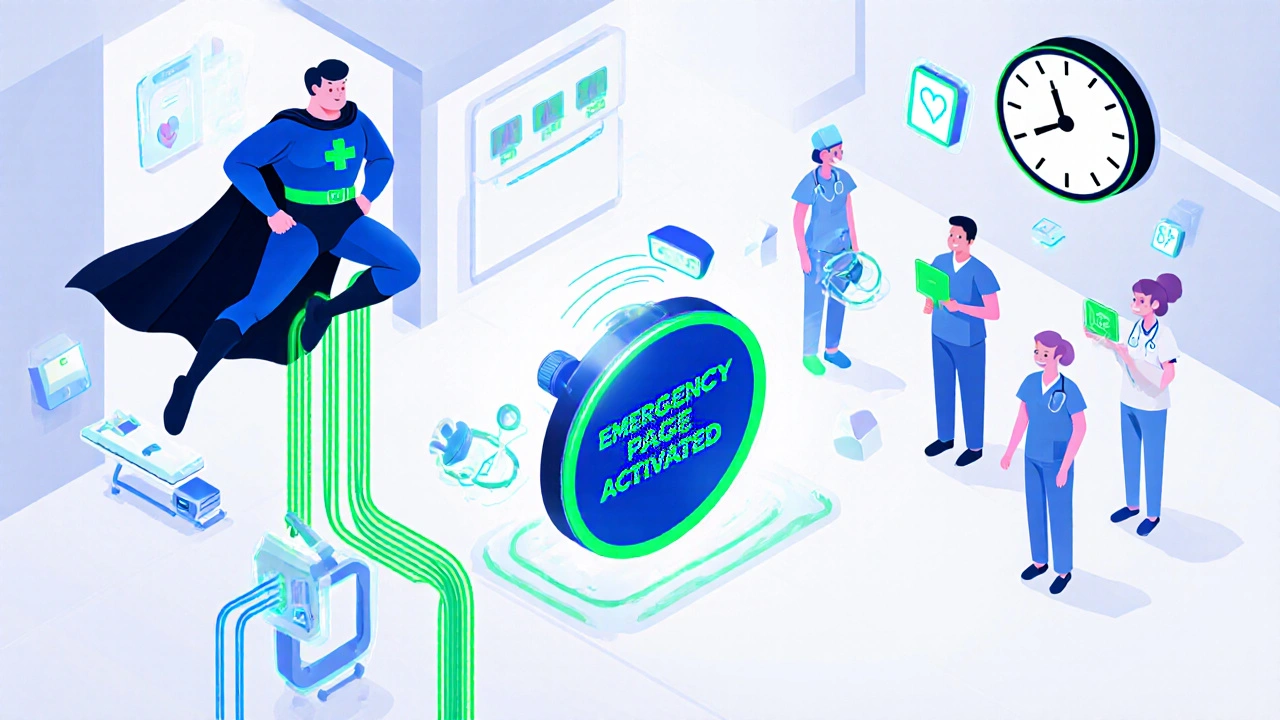Why Your Business Still Needs Overhead Paging in a VoIP World
You’ve upgraded to Zoom Phone or Microsoft Teams. Your phones are all IP-based. Your calls sound crystal clear. But when it’s time to announce a fire drill, call a nurse to the ER, or remind students to get to class, you’re still stuck with a clunky analog speaker system in the ceiling. Why? Because most VoIP systems don’t talk to your old PA horns - unless you add a SIP paging adapter.
SIP paging adapters are the quiet heroes behind the scenes in hospitals, schools, warehouses, and office campuses. They let you use your existing VoIP network to blast announcements through ceiling speakers, wall horns, and public address systems - no rewiring, no new cabling, no expensive analog phone lines. You’re not replacing your PA system. You’re upgrading it to work with your modern phone system.
Companies like CyberData, Algo, and Viking have been making these devices since the early 2010s. Today, they’re not optional. They’re essential. A 2022 case study of 50 enterprise deployments showed businesses saved about 35% on total paging costs by switching from analog to SIP-based systems. That’s not just money. It’s fewer maintenance calls, fewer dead zones, and fewer failed emergency alerts.
How SIP Paging Adapters Actually Work
Think of a SIP paging adapter like a translator. On one side, it speaks VoIP. It connects to your network, gets an IP address, and registers with your PBX or cloud phone system like Zoom or Microsoft Teams. On the other side, it speaks audio. It outputs a line-level signal that plugs into your existing amplifier or directly into a powered horn.
When someone dials a paging extension - say, *99 - the adapter receives a SIP INVITE message. It converts that into an audio stream using G.711 codec (64 kbps), then sends it out through its audio jack. The amplifier boosts the signal, and your overhead speakers blare the message. No ringing. No pickup. Just instant broadcast.
There are two main ways this happens: unicast and multicast. Unicast is simple. One adapter, one speaker zone. You dial *99, and only the device assigned to that number plays the message. It’s perfect for small offices with one or two zones.
Multicast is for bigger setups. Instead of calling one device, you send the audio to a group address - like 239.192.1.1:5004. Every SIP paging adapter on your network tuned to that address hears it. This is how a school can page the entire campus at once. But it needs proper network setup: IGMP snooping enabled on switches, QoS tags on the audio traffic, and no Spanning Tree Protocol blocking the stream.
Choosing the Right Adapter for Your Setup
Not all SIP paging adapters are the same. Your choice depends on what kind of speakers you have and how many zones you need.
If you’re connecting to an existing amplifier with RCA or XLR inputs, go for a line-output adapter:
- Algo 8301 - Best for legacy amps. Outputs -10dBV to +4dBV. Easy to set up. Handles one zone. $349.
- CyberData 011233 - More complex but powerful. Supports up to 9 priority levels. Ideal for hospitals or emergency systems. $429.
If you want to skip the amplifier entirely, pick an adapter with a built-in amp:
- Snom PA1 - One unit does it all. 10W output. Mounts like a speaker. $299. Great for small rooms or hallways.
If you’re replacing old analog phones with paging ports, you might need an FXS adapter:
- Grandstream HT814 - Four FXS ports. Lets you plug in four analog horns or amplifiers. $199.99. Good for budget setups.
- Poly Obi302 - Two FXS ports. $129.99. Solid for small clinics or retail stores.
Here’s how they stack up:
| Model | Output Type | Zones Supported | Priority Levels | Price (MSRP) | Best For |
|---|---|---|---|---|---|
| CyberData 011233 | Line Out (Balanced) | Up to 16 (via multicast) | 9 | $429 | Hospitals, campuses, emergency systems |
| Algo 8301 | Line Out (RCA) | 1 | 1 | $349 | Legacy amplifiers, simple setups |
| Snom PA1 | Built-in Amplifier | 1 | 1 | $299 | Small rooms, retail, labs |
| Grandstream HT814 | 4x FXS Ports | 4 | 1 per port | $199.99 | Low-budget, multi-zone analog systems |
| Viking PA-2A | Line Out + Dry Contact | 1 | 1 | $399 | Fire alarms, relay triggers, NFPA 72 compliance |
Don’t just pick the cheapest. If you’re in a hospital, you need priority levels. If you’re in a school, you need multicast. If you’re on a tight budget, the Grandstream HT814 gives you four zones for under $200.

Network Setup: The Hidden Pitfall
Most failures aren’t with the hardware. They’re with the network.
Here’s what you must get right:
- Use CAT6 cable - Especially if your speakers are more than 50 meters from the switch. CAT5e might work, but it’s risky.
- Disable Spanning Tree Protocol - Or enable PortFast on the switch port. STP can delay audio by 30 seconds, making your paging useless during emergencies.
- Set up a dedicated VLAN - 78% of enterprise users do this. Isolate paging traffic from regular calls. Prevents interference and improves reliability.
- Enable QoS - Tag SIP and RTP traffic as high priority. Audio must stay under 150ms latency. If it doesn’t, your message gets choppy or drops.
- Open the right ports - SIP uses UDP 5060. RTP uses 10,000-20,000. For multicast, ensure UDP 239.192.1.1:5004 (or similar) is allowed.
- Enable IGMP snooping - If you’re using multicast. Without it, your switches flood the entire network with paging traffic. That’s how you get 100% CPU spikes on your core switch.
A 2023 whitepaper from Nemertes Research found that 28% of all VoIP quality issues in enterprises came from misconfigured paging adapters. Almost all were network-related. Don’t be one of them.
Emergency Paging and Compliance
If you’re paging for safety - fire drills, lockdowns, medical alerts - you’re not just installing hardware. You’re complying with the law.
NFPA 72, the National Fire Alarm and Signaling Code, requires emergency paging systems to deliver at least 90dB at 10 feet from the speaker. It also requires 24-hour battery backup. Most consumer-grade adapters don’t meet this. But professional models like the Viking PA-2A do. They’re designed to trigger relays that activate backup power during outages.
Also, don’t forget about access control. Unauthorized paging is a real problem. A school in Ohio reported a student broadcasting prank messages through the system for weeks before they caught it. CyberData and Algo both let you set security codes. Only users with the right PIN can page. 92% of healthcare facilities use this feature.

Real-World Problems and Fixes
Here’s what users actually run into - and how they fix it:
- Audio distortion - 29% of installs. Usually caused by impedance mismatch. If your amplifier expects 600 ohms but the adapter outputs 10k ohms, the sound gets muddy. Solution: Use a matching transformer or switch to a line-level adapter like Algo 8301.
- DTMF tones not working - Grandstream HT814 users report this in 17% of cases. Firmware update fixes it. Always check for the latest version.
- Paging fails during drills - Traced to IGMP snooping turned off. Fix: Log into your switch and enable it. Check vendor docs for exact steps.
- Too many steps to page - CyberData’s web interface is powerful but confusing. Users say it takes 3-5 hours to set up. Solution: Use a SIP phone with a dedicated paging button. Or use a third-party app like Zoiper to trigger the extension with one tap.
Pro tip: Test your system monthly. Don’t wait for an emergency. Record a 10-second test message and play it every first Friday of the month. Make sure every horn works. Keep a log.
What’s Next? The Future of SIP Paging
VoIP paging isn’t standing still. In 2023, Algo added Amazon Alexa integration. Say, “Alexa, page the cafeteria,” and it happens. CyberData’s firmware 20.0.0 added Zoom Phone certification. That’s huge - Zoom didn’t support native paging before.
But here’s the real shift: companies are starting to build paging into their IP phones. New models from Poly and Yealink now have built-in speaker buttons. You can page your entire floor from your desk phone. That’s convenient - but it doesn’t replace overhead horns. You still need those for the warehouse, the gym, the parking lot.
Analysts predict that by 2027, dedicated SIP paging adapters will serve only 45% of today’s market. But that still leaves 55% - and that’s the part that matters most: legacy infrastructure. Hospitals, schools, and factories aren’t tearing out their ceiling speakers. They’re just adding SIP adapters to make them smarter.
And that’s why SIP paging adapters aren’t going away. They’re evolving. They’re becoming the bridge between old and new. Between safety and technology. Between silence and a voice that needs to be heard - loud and clear - when it matters most.
